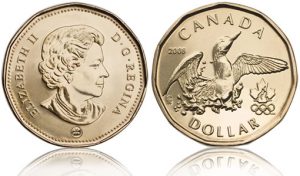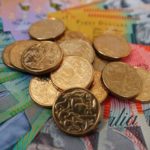 Yesterday’s trade saw USD/CAD within the range of 1.3034-1.3095. The pair closed at 1.3041, going up 0.17% on a daily basis. It has been the 54th gain in the past 105 trading days and also a second consecutive one. The daily high has been the highest level since May 25th, when a high of 1.3135 was registered. The major pair has pared its advance to 4.02% so far during the current month, following three consecutive months of decline.
Yesterday’s trade saw USD/CAD within the range of 1.3034-1.3095. The pair closed at 1.3041, going up 0.17% on a daily basis. It has been the 54th gain in the past 105 trading days and also a second consecutive one. The daily high has been the highest level since May 25th, when a high of 1.3135 was registered. The major pair has pared its advance to 4.02% so far during the current month, following three consecutive months of decline.
At 7:44 GMT today USD/CAD was edging up 0.10% on the day to trade at 1.3054. The pair touched a daily high at 1.3062 at 7:21 GMT, overshooting the range resistance level (R3) and a daily low at 1.3018 during mid-Asian trade.
Meanwhile, crude oil futures marked their 64th gain in crude oil prices out of the past 116 trading days. Oil for July delivery went up as high as $49.75 per barrel on May 30th, or the highest level since May 26th, and closed at $49.51, edging up 0.37% compared to Friday’s close. As of 8:26 GMT today the commodity was edging down 0.24% to trade at $49.39, after going down as low as $49.36 per barrel earlier.
On Tuesday USD/CAD trading may be influenced by the following macroeconomic reports as listed below.
Fundamentals
United States
Personal Income, Personal Spending
Personal spending in the United States probably rose 0.7% in April, according to market expectations, while personal income was probably up for a 13th consecutive month in April, increasing at a monthly rate of 0.4%. If expectations were met, Aprils rate of increase in spending would be the steepest one since May 2015, when a gain rate of 0.7% was reported.
Consumer spending, which accounts for over two thirds of the nations GDP, rose 0.1% (USD 12.8 billion) in March. At the same time, personal income increased 0.4% (USD 57.4 billion) during the same month, while disposable personal income (DPI) rose by USD 50.4 billion.
Wages and salaries were up USD 29.2 billion in March, following a drop by USD 4.6 billion in the preceding month, while supplements to wages and salaries rose USD 5.4 billion in March, after going up USD 3.0 billion in February. Private sector wages and salaries went up USD 26.3 billion in March, after a drop by USD 8.0 billion a month ago, while government wages and salaries rose USD 2.8 billion, after going up by USD 3.4 billion in February.
Higher-than-expected rates of increase imply good employment conditions and, therefore, are dollar positive. The Bureau of Economic Analysis is to publish the official figures at 12:30 GMT.
Chicago Manufacturing PMI
The Chicago Purchasing Managers Index (PMI) probably improved to a reading of 50.9 in May, according to market expectations, from 50.4 during the prior month. The latter has been the lowest reading since February, when the PMI came in at 47.6. The index reflects business conditions in the regions manufacturing sector and is interrelated with the Manufacturing Index, published by the Institute for Supply Management (ISM). A reading above the key level of 50.0 is indicative of optimism (expansion in manufacturing activity). In case the PMI improved more than forecast, this would have a moderate bullish effect on the US dollar. The ISM-Chicago Inc. will release the official reading of this key barometer at 13:45 GMT.
Conference Board Consumer Confidence Index
Confidence among consumers in the United States probably improved in May, with the corresponding index coming in at a reading of 96.0, according to market expectations. In April the gauge was reported at 94.2.
This indicator measures the level of individuals confidence in the US economic development. It is considered as a leading indicator, as it gives an early insight into consumer spending, which accounts for a major part of the nations GDP.
In case the index came above expectations, this would have a strong bullish effect on the US dollar, as higher confidence suggests a greater willingness to spend and, respectively, an accelerated economic growth. The Conference Board research group is to publish the official index reading at 15:00 GMT.
Canada
Gross Domestic Product
Canadian Gross Domestic Product (GDP) probably expanded at a rate of 2.9% in Q1 compared to the same quarter a year earlier, according to the median forecast by experts, following a 0.8% growth in the preceding quarter. If expectations were met, this would be the strongest annual growth rate since Q3 2014, when Canadas GDP expanded at a revised up 3.2%.
In case the economy grew at a faster-than-anticipated rate in Q1, this would be a strong bullish impulse for the loonie. Statistics Canada is expected to release the official report at 12:30 GMT.
Daily and Weekly Pivot Levels
By employing the Camarilla calculation method, the daily pivot levels for USD/CAD are presented as follows:
R1 – 1.3047
R2 – 1.3052
R3 (range resistance) – 1.3058
R4 (range breakout) – 1.3075
S1 – 1.3035
S2 – 1.3030
S3 (range support) – 1.3024
S4 (range breakout) – 1.3007
By using the traditional method of calculation, the weekly pivot levels for USD/CAD are presented as follows:
Central Pivot Point – 1.3039
R1 – 1.3170
R2 – 1.3322
R3 – 1.3453
S1 – 1.2887
S2 – 1.2756
S3 – 1.2604





